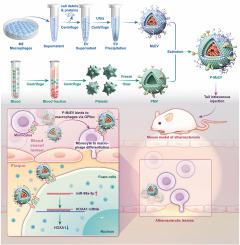当前位置:
X-MOL 学术
›
Bioact. Mater.
›
论文详情
Our official English website, www.x-mol.net, welcomes your feedback! (Note: you will need to create a separate account there.)
Engineered M2 macrophage-derived extracellular vesicles with platelet membrane fusion for targeted therapy of atherosclerosis
Bioactive Materials ( IF 18.9 ) Pub Date : 2024-02-17 , DOI: 10.1016/j.bioactmat.2024.02.015 Lan Xie , Jinyong Chen , Haochang Hu , Yuan Zhu , Xiying Wang , Siyu Zhou , Feifan Wang , Meixiang Xiang
Bioactive Materials ( IF 18.9 ) Pub Date : 2024-02-17 , DOI: 10.1016/j.bioactmat.2024.02.015 Lan Xie , Jinyong Chen , Haochang Hu , Yuan Zhu , Xiying Wang , Siyu Zhou , Feifan Wang , Meixiang Xiang

|
Atherosclerosis is featured as chronic low-grade inflammation in the arteries, which leads to the formation of plaques rich in lipids. M2 macrophage-derived extracellular vesicles (MEV) have significant potential for anti-atherosclerotic therapy. However, their therapeutic effectiveness has been hindered by their limited targeting capability . The objective of this study was to create the P-MEV (platelet membrane-modified MEV) using the membrane fusion technique in order to imitate the interaction between platelets and macrophages. P-MEV exhibited excellent physicochemical properties, and microRNA (miRNA)-sequencing revealed that the extrusion process had no detrimental effects on miRNAs carried by the nanocarriers. Remarkably, miR-99a-5p was identified as the miRNA with the highest expression level, which targeted the mRNA of Homeobox A1 (HOXA1) and effectively suppressed the formation of foam cells In an atherosclerotic low-density lipoprotein receptor-deficient () mouse model, the intravenous injection of P-MEV showed enhanced targeting and greater infiltration into atherosclerotic plaques compared to regular extracellular vesicles. Crucially, P-MEV successfully suppressed the progression of atherosclerosis without causing systemic toxicity. The findings demonstrated a biomimetic platelet-mimic system that holds great promise for the treatment of atherosclerosis in clinical settings.
中文翻译:

工程化M2巨噬细胞衍生的具有血小板膜融合的细胞外囊泡用于动脉粥样硬化的靶向治疗
动脉粥样硬化的特征是动脉中的慢性低度炎症,导致富含脂质的斑块形成。 M2 巨噬细胞来源的细胞外囊泡 (MEV) 具有抗动脉粥样硬化治疗的巨大潜力。然而,它们的治疗效果因其有限的靶向能力而受到阻碍。本研究的目的是利用膜融合技术创建 P-MEV(血小板膜修饰 MEV),以模拟血小板和巨噬细胞之间的相互作用。 P-MEV 表现出优异的理化特性,并且 microRNA (miRNA) 测序表明,挤出过程对纳米载体携带的 miRNA 没有有害影响。值得注意的是,miR-99a-5p被确定为表达水平最高的miRNA,它靶向同源盒A1(HOXA1)的mRNA,并在动脉粥样硬化低密度脂蛋白受体缺陷()小鼠模型中有效抑制泡沫细胞的形成与常规细胞外囊泡相比,静脉注射 P-MEV 显示出增强的靶向性和对动脉粥样硬化斑块的更大浸润。至关重要的是,P-MEV 成功抑制了动脉粥样硬化的进展,且不会引起全身毒性。研究结果表明,仿生血小板模拟系统对于临床治疗动脉粥样硬化具有广阔的前景。
更新日期:2024-02-17
中文翻译:

工程化M2巨噬细胞衍生的具有血小板膜融合的细胞外囊泡用于动脉粥样硬化的靶向治疗
动脉粥样硬化的特征是动脉中的慢性低度炎症,导致富含脂质的斑块形成。 M2 巨噬细胞来源的细胞外囊泡 (MEV) 具有抗动脉粥样硬化治疗的巨大潜力。然而,它们的治疗效果因其有限的靶向能力而受到阻碍。本研究的目的是利用膜融合技术创建 P-MEV(血小板膜修饰 MEV),以模拟血小板和巨噬细胞之间的相互作用。 P-MEV 表现出优异的理化特性,并且 microRNA (miRNA) 测序表明,挤出过程对纳米载体携带的 miRNA 没有有害影响。值得注意的是,miR-99a-5p被确定为表达水平最高的miRNA,它靶向同源盒A1(HOXA1)的mRNA,并在动脉粥样硬化低密度脂蛋白受体缺陷()小鼠模型中有效抑制泡沫细胞的形成与常规细胞外囊泡相比,静脉注射 P-MEV 显示出增强的靶向性和对动脉粥样硬化斑块的更大浸润。至关重要的是,P-MEV 成功抑制了动脉粥样硬化的进展,且不会引起全身毒性。研究结果表明,仿生血小板模拟系统对于临床治疗动脉粥样硬化具有广阔的前景。



























 京公网安备 11010802027423号
京公网安备 11010802027423号